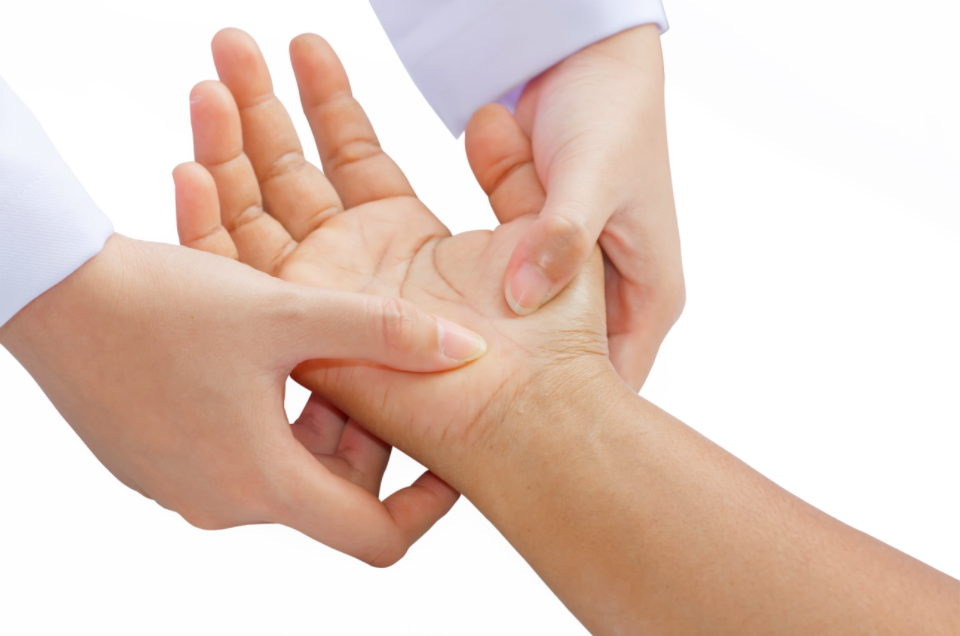
Our hands are the main tools that we use to navigate the world around us. Most—if not all—professions require some use of the hands to complete the task, whether that’s grooming dogs, typing at a computer, or trimming trees. Unfortunately, these repetitive motions can irritate and damage certain structures of the hand and wrist, as we explored in our last post. Over time, this can lead to the development of a repetitive strain injury (RSI), which can cause a variety of symptoms in the hand and wrist that will interfere with hand function and make it a challenge to perform tasks normally. Some common RSIs involve irritation of nerves as they pass through the wrist, and we’re going to discuss each of those below.
Carpal tunnel syndrome
The carpal tunnel is a space at the base of the palm that contains several tendons and the median nerve, which provides sensation to most of our fingers. If these tendons and soft tissue thicken or any other swelling occurs in the area, the tunnel narrows, which puts pressure on the median nerve and leads to carpal tunnel syndrome. Symptoms usually start with a burning or tingling sensation, but eventually pain, weakness, and/or numbness develop in the hand and wrist, and then radiate up the arm. As carpal tunnel syndrome progresses, symptoms usually get worse when holding certain items, and the weakness and numbness may occur more frequently if pressure on the nerve persists.
Carpal tunnel syndrome affects about 5% of the population, and the greatest risk factor is performing any task that requires repetitive hand motions, awkward hand positions, strong gripping, mechanical stress on the palms, or vibration. Although office work and repetitive typing may be a potential cause, the professions most frequently associated with carpal tunnel syndrome are those that involve sewing, baking, cleaning, or assembly–line work.
Cubital tunnel syndrome
The ulnar nerve is a major nerve that travels from the neck down to the hand, where it provides sensation to the little finger and half of the ring finger. This nerve can become compressed—or squeezed—by nearby structures at any point along the way. But the most common place this compression occurs is behind the inside of the elbow at the cubital tunnel, a narrow passageway for the ulnar nerve.
The result of this ulnar nerve compression is cubital tunnel syndrome, which is the second most common nerve compression syndrome of the arm after carpal tunnel syndrome. Symptoms are also similar, as pain, numbness, tingling, and weakness in the arm and hand—especially in the ring and little fingers—are most common. Cubital tunnel syndrome is also caused by daily habits like leaning on the elbow for long periods of time, sleeping with the arms bent, or from direct trauma to the ulnar nerve, like hitting your “funny bone.”
Guyon canal syndrome
The Guyon canal is another “tunnel” for the ulnar nerve that is formed by two bones in the wrist (the pisiform and hamate). When the ulnar nerve is compressed at this location, the resulting condition is called Guyon canal syndrome—or ulnar tunnel syndrome—which is far less common than carpal tunnel syndrome; however, both conditions will occur at the same time in some cases.
Guyon canal syndrome often develops due to overuse, particularly from activities like heavy gripping, twisting, and other repeated hand and wrist motions. Repetitive work with the hand bent down and outward and repeated pressure on the hand—such as in cyclists, weightlifters, and with regular use of a jackhammer—can also cause pressure or irritation of the ulnar nerve at the Guyon canal. Symptoms include pins and needles in the ring and little fingers, which may progress to a burning pain, decreased sensation, weakness, and difficulty spreading the fingers and pinching.
Physical therapy and nerve mobilization exercises can effectively alleviate symptoms
If you notice symptoms that sound like any of these conditions, your first step should be to evaluate your daily habits and behaviors to detect any repetitive movements that could be contributing factors. The tips we provided in our last post can be used to treat as well as prevent overuse injuries like carpal tunnel syndrome, cubital tunnel syndrome, and Guyon canal syndrome, but they may not provide you with adequate relief on their own.
In these cases, a course of physical therapy may be needed to manage your condition. A typical physical therapy treatment program will include bracing or splinting, modalities like ultrasound and electrical stimulation, and advice on how to make modifications to your lifestyle and posture. But the central component of most programs for these nerve–related conditions is targeted exercises that help to move the affected nerve away from the compression forces. Nerve mobilization exercises are designed to help glide or mobilize the ulnar nerve and encourage normal movement through the cubital tunnel or Guyon canal, which can effectively alleviate pain and other symptoms. A similar approach is also recommended for carpal tunnel syndrome, as specific exercises can decrease swelling and adhesion in the carpal tunnel, thereby mobilizing the median nerve and reducing pain levels in the process. Below are a few examples of nerve mobilization exercises for each of these conditions:
Carpal tunnel syndrome
Cubital tunnel syndrome
Guyon canal syndrome
In our next two posts, we’ll explore how RSIs can also result from overtraining in sports like golf and tennis.
